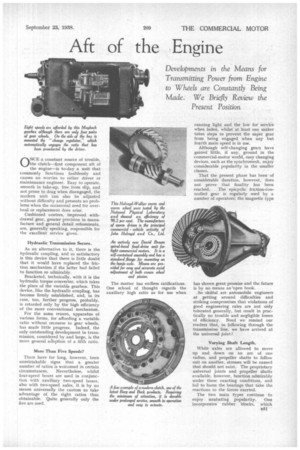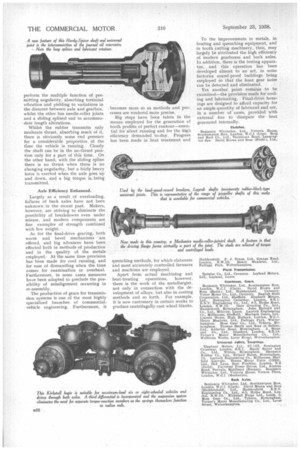Aft of the Engine
Page 85

Page 86

If you've noticed an error in this article please click here to report it so we can fix it.
Developments in the Means for Transmitting Power from Engine to Wheels are Constantly Being Made. We Briefly Review the
Present Position
ONCE a constant source of trouble, the clutch—first component aft of the engine—is to-day a unit that commonly functions faultlessly and causes no worries to either driver or maintenance engineer. Easy to operate, smooth in take-up, free from slip, and not prone to drag when disengaged, the modern unit can also be adjusted without difficulty and presents no problems when the occasional need for overhaul or replacement does arise.
Cushioned centres, improved withdrawal gear, greater precision in manufacture and general detail refinements, are, generally speaking, responsible for the excellent service given.
Hydraulic Transmission Secure.
As an alternative to it, there is the hydraulic coupling, and so satisfactory is this device that there is little doubt that it would have replaced the friction mechanism if the latter had failed to function so admirably.
Bracketed, technically, with it is the hydraulic torque converter, which takes the place of the variable gearbox. This device, like the hydraulic coupling, has become firmly established, and, in its case, too, further progress, probably, is retarded only by the high efficiency of the more conventional mechanism.
For the same reason, apparatus of various forms, for affording a variable ratio without recourse to gear wheels, has made little progress. Indeed, the only outstanding development in transmission, considered by and large, is the more general adoption of a fifth ratio.
More Than Five Speeds?
There have for long, however, been unmistakable signs that a greater number of ratios is welcomed in certain circumstances. Nevertheless, whilst four-speed boxes are used in conjunction with auxiliary two-speed boxes, also with two-speed axles, it is by no means universally the custom to take advantage of the eight ratios thus obtainable. Quite generally only the five are used. The matter has endless ratifications. One school of thought regards the auxiliary high ratio as for use when running light and the low for service when laden, whilst at least one maker takes steps to prevent the super gear from being engaged when any but fourth main speed is in use.
Although self-changing gears have gained little, if any, ground in the commercial-motor world, easy changing devices, such as the synchromesh, enjoy considerable popularity in the smaller classes.
That the present phase has been of considerable duration, however, does not prove that finality has been
reached. The epicyclic friction-controlled gear is regularly used by a number of operators; the magnetic type has shown great promise and the future is by no means an 'open book.
So skilful are automobile engineers at getting around difficulties and striking compromises that violations of good engineering rules are not only tolerated generally, but result in practically no trouble and negligible losses of efficiency. Need we remind our readers that, in following through the transmission line, we have arrived at the universal joint?
Varying Shaft Length.
While axles are allowed to move up and down on an arc of one radius, and propeller shafts to follow suit on another, stresses will be caused that should not exist. The proprietary universal joints and propeller shafts available, however, function admirably under these exacting conditions, and fail to harm the bearings that take the reactions to the forces exerted.
The two main types continue to enjoy unabating popularity. One incorporates rubber blocks, which 85 perform the multiple function of permitting angularity, absorbing torsional vibration and yielding to variations in the distance between axle and gearbox, whilst the other has needle-roller joints and a sliding splined end to accommodate length alterations.
Whilst the rubber transmits only moderate thrust, absorbing much of it, there is obviously some end pressure for a considerable proportion of the lime, the vehicle is running. Clearly the shaft can be in the no-thrust position only for a part of this time. On the other hand, with the sliding spline there is no thrust when there is no changing angularity, but a fairly heavy force is exerted when the axle goes up and down, and a big torque is being transmitted_ Axle Efficiency Enhanced.
Largely as a result of overloading, failures of back axles have not been unknown in the recent past. Makers, however, are striving to eliminate the possibility of breakdowns even under misuse, and modern components are fine examples of strength combined with low weight.
As for the final-drive gearing, both worm and bevel mechanisms are offered, and big advances have been effected both in methods of production and in the quality of the metals employed. At the same time provision has been made for cool running, and for ease of dismantling when the time comes for examination or overhaul. Furthermore, in some cases measures have been adopted to preclude the possibility of misalignment occurring in re-assembly.
The production of gears for transmission systems is one of the most highly specialized branches of commercialvehicle engineering. Furthermore, it becomes more do as methods and processes are rendered more precise.
Big steps have been taken in the means employed for the generation of tooth profiles of perfect contour—essential for silent running and for the high efficiency demanded to-day. Progress has been made in heat treatment and quenching methods, for which elaborate and most accurately controlled furnaces and machines are employed.
Apart from actual machining and heat-treating operations, however, there is the work of the metallurgist, not only in connection with the development of alloys, but also in casting methods and so forth. For example, it is now customary in certain works to produce centrifugally cast wheel blanks. To the improvements in metals, in heating and quenching equipment, and in tooth cutting machinery, then, may largely be attributed the high efficiency of modern gearboxes and back axles. In addition, there is the testing apparatus, and this operation has been developed almost to an art, in some factories sound-proof buildings being employed so that the least gear noise • can be detected and eliminated.
Yet another point remains to be examined—the provision made for cooling and lubricating. Final-drive housings are designed to afford capacity for an ample quantity of lubricant and are, in a number of cases, provided with external fins to dissipate the heat generated internally.
Clutches.
Benjamin Whittaker, Ltd, Victoria House, Southampton Row, London, W.C./ (Lipe). Borg and Beck Co., Ltd., Tachbrook Road, Leamington Spa. David Brown and Sons (Rudd.), Ltd., Huddersfield. F. J. Evans, Ltd.. Grange Road, London, N.W.10. Henry Meadows, Ltd.. Fallings Park, Wolverhampton.
Fluid Transmission.
Daimler Co., Ltd., Coventry. Leyland Motors, Ltd., Leyland, Lanes.
Gearboxes, Gears.
• Benjamin Whittaker, Ltd., Southampton Row, London. W.C.1 (Clark). David Brown and
Sons (Rudd.), Ltd., Huddersfield. CoventryVictor Motor Co.. Ltd., Coventry. English Steel Corporation, Ltd., Sheffield. Elephant Motors, Ltd Newington Causeway, London, S.E.1. E.N.V. Engineering Co., Ltd., 4-5, Hythe Road, London, N.W.10. Gear Grinding Co., Ltd., Handsworth, Birmingham. John Holroyd and Co., Ltd., Milnrow, Lanes. Laycock Engineering Co., Millhouses, Sheffield. Maybach Gears, Ltd.. Lincoln House, High Holborn, London, W.C.I. Henry Meadows, Ltd., Fallings Park, Wolverhampton. Moss Gear .Co., Ltd., Tyburn, Birmingham. Thomas Smith and Sons of Saltley, Ltd., Adderley Road, Birmingham. J. Stone and Co., Ltd., Deptford, London, S.E.14. Turners Motor Manufaoturing Co.' Ltd., Wulfruna Works, Lever Stre,t, Wolverbairinton.
Universal Jolts, couplings.
Elephant Motors, Ltd., 97-103, Newington Causeway, London, SE-i. Hardy Spicer and Co., Ltd., Witton, Birmingham. Hermetic Rubber Co., Ltd., Ryland Street, Birmingham, 16. Laycock Engineering Co., Millhauses, Sheffield (Layrub). Simms Motor Units (1920), Ltd., Oak Lane, East Finchley, London, N.2 (Jurid). Universal Power Drives, Ltd., Aintree Road, Perivale, Middlesex (Rgeppa). Benjamin Whittake ,r Ltd., Victoria ,House, Vernon Place, London, W.C.1 (Mechanics).
Back Axles.
Benjamin Whittaker, Ltd. Bouthamtpon Row, London, W.C.I.(Clark). Da!vid Brown and Sons . (Huddersfield), Ltd., Huddersfield. E.N.V. Engineering Co., Ltd., 4-5, Hythe Read, London, N.W.10. Kirkstall Forge Ltd., Leeds 5. Moss Gear Co. Ltd., Tyhurn,
Turner's Motor Manufacturing Co:, Ltd., Lever Street, Wolverhampton.












































































































































